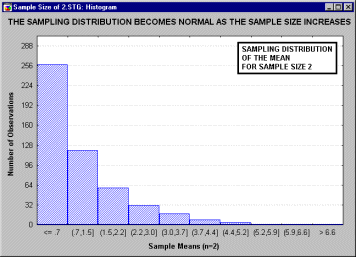 Probability and
Statistics began as two separate and distinct disciplines. Probability began in an effort to
predict
outcomes of games and situations of chance, while statistics was created
in an
effort to draw inferences from available data. The relationship between the two disciplines was not readily
apparent
until the early nineteenth century and not widely applied until the mid to
latter part of that century.
Before the correlation between the two was realized, the lack of a
concrete set of axioms prevented statistics from being accepted as a true
science. But, once probability was
implemented to provide a solid mathematical foundation on which the
theories of
statistics could be supported, statistics was accepted as a well founded
science
and there was a widespread acknowledgement of its validity and
applicability. Probability and
Statistics began as two separate and distinct disciplines. Probability began in an effort to
predict
outcomes of games and situations of chance, while statistics was created
in an
effort to draw inferences from available data. The relationship between the two disciplines was not readily
apparent
until the early nineteenth century and not widely applied until the mid to
latter part of that century.
Before the correlation between the two was realized, the lack of a
concrete set of axioms prevented statistics from being accepted as a true
science. But, once probability was
implemented to provide a solid mathematical foundation on which the
theories of
statistics could be supported, statistics was accepted as a well founded
science
and there was a widespread acknowledgement of its validity and
applicability. The
mathematical
groundwork that initiated this merge was done by Carl Fredrich Gauss
(1777-1855) and Pierre Simon Laplace (1749-1847). While working on the
mathematics of planetary orbits Gauss realized that probability theory
provided
the fundamental principles needed to validate Adrien Marie Legendre’s
(1752-1833) results on the method of least squares (1805). In his publication, Theoria Motus
Corporum Coelestium in Sectionibus Conisis Solum Ambientium (“The
Theory of
the Motion of Heavenly Bodies Moving about the Sun in Conic Sections”)
(1809),
Gauss provided a proof, based on probability, to the problem of
leastsquares. Although Gauss’
logical
reasoning was faulty, it provided Laplace with new insights to the use of
his
central limit theorem and probability in statistics. Laplace applied his central limit theorem to Gauss’
reasoning on
linear estimation to provide a solid solution to the error curve and thus
to
the method of least squares. Once Laplace was introduced to the idea of
merging
probability and statistics, he began applying probability to statistics in
many
ways, such as to refine his original proof on the method of least squares
and
to reach results concerning weighted least squares. Gauss’ and Laplace’s
appplication of probability to justify statistical theories created the
spark
that eventually led to the blending of probability and statistics. The
mathematical
groundwork that initiated this merge was done by Carl Fredrich Gauss
(1777-1855) and Pierre Simon Laplace (1749-1847). While working on the
mathematics of planetary orbits Gauss realized that probability theory
provided
the fundamental principles needed to validate Adrien Marie Legendre’s
(1752-1833) results on the method of least squares (1805). In his publication, Theoria Motus
Corporum Coelestium in Sectionibus Conisis Solum Ambientium (“The
Theory of
the Motion of Heavenly Bodies Moving about the Sun in Conic Sections”)
(1809),
Gauss provided a proof, based on probability, to the problem of
leastsquares. Although Gauss’
logical
reasoning was faulty, it provided Laplace with new insights to the use of
his
central limit theorem and probability in statistics. Laplace applied his central limit theorem to Gauss’
reasoning on
linear estimation to provide a solid solution to the error curve and thus
to
the method of least squares. Once Laplace was introduced to the idea of
merging
probability and statistics, he began applying probability to statistics in
many
ways, such as to refine his original proof on the method of least squares
and
to reach results concerning weighted least squares. Gauss’ and Laplace’s
appplication of probability to justify statistical theories created the
spark
that eventually led to the blending of probability and statistics.
Adolphe Quetelet (1796-1874) was initially responsible for utilizing and applying this conjunction of probability and statistics to the social sciences. During a brief hiatus to Paris in 1823 to study astronomy, Quetelet was instructed in the many uses of probability by Pierre Simon Laplace (1749-1827) and John Baptiste Joseph Fourier (1768–1830). Although Quetelet’s work inspired the use of probability in the social sciences, most statisticians were hesitant to wholeheartedly utilize estimates based on probability, mainly due to their unwillingness to justify results founded on samples rather than on the entire population. A work published in 1840 by Jules Gavarret, addressing adequate sample sizes to ensure accurate inferences, was influential in the trend to accept sampling as a sufficient population representative and a means to reduce results to a workable size. This trend was also influenced by Gustav Theodor Fechner’s work in psychophysics and Wilhelm Lexis’ work on statistical series. The reluctance to accept the complete melding of probability and statistics was primarily dispelled by the results obtained through the application of probability to statistics in the social sciences. The acceptance to merge the fields of probability and statistics was a gradual process which ended in statistics as we know it today. Probability is such a strong and versatile science, applicable to many other areas of science, but it is also the heart of statistics, providing the necessary groundwork on which statistics is built. Without the axioms of probability on which statistics finds its support, statistics would merely be data collection without the ability to make the necessary inferences on future events. | ||||